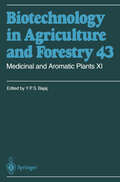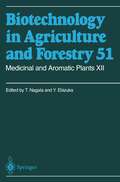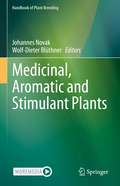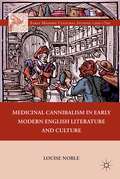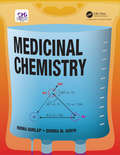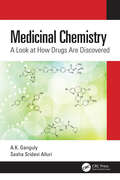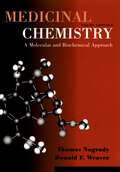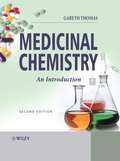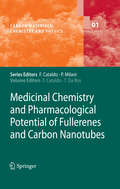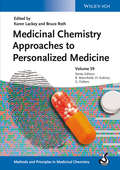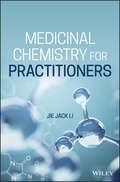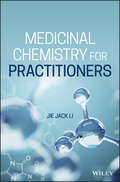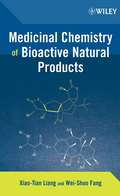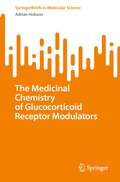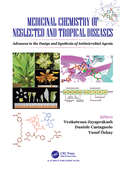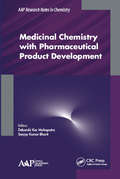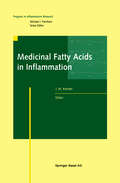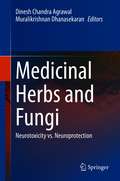- Table View
- List View
Medicinal and Aromatic Plants XII (Biotechnology in Agriculture and Forestry #51)
by Toshiyuki Nagata Yutaka EbizukaMedicinal, Aromatic and Stimulant Plants (Handbook of Plant Breeding #12)
by Johannes Novak Wolf-Dieter BlüthnerThe agricultural sector of medicinal (including plant stimulants) and aromatic plants is characterized by an enormous number and diversity of species. Only a few of them can be considered cultivated crops in which significant breeding efforts are made. For most species, however, breeding is performed in short-term projects only. Therefore, basic knowledge about these species is still fragmentary. Our intention is to compile and organize the available information on the most commonly utilized plant species into one publication, thereby providing a standardized resource for the researchers and the grower community. This book therefore provides reference source materials for a wide variety of plant species used for human consumption due to their flavor, medicinal or recreational properties. It is divided into a section of general topics on genetic resources, breeding adaptation of analytic methods and a compilation of basic data for DNA content, chromosome number and mating system followed by a section of 20 monographs on a species or species groups.
Medicinal Cannibalism in Early Modern English Literature and Culture (Early Modern Cultural Studies 1500–1700)
by L. NobleThe human body, traded, fragmented and ingested is at the centre of Medicinal Cannibalism in Early Modern English Literature and Culture , which explores the connections between early modern literary representations of the eaten body and the medical consumption of corpses.
Medicinal Chemistry
by Norma K Dunlap Donna M HurynMedicinal Chemistry begins with the history of the field, starting from the serendipitous use of plant preparations to current practice of design- and target-based screening methods. Written from the perspective of practicing medicinal chemists, the text covers key drug discovery activities such as pharmacokinetics and patenting, as well as the classes and structures of drug targets (receptors, enzymes, nucleic acids, and protein-protein and lipid interactions) with numerous examples of drugs acting at each type. Selected therapeutic areas include drugs to treat cancer, infectious diseases, and central nervous system disorders. Throughout the book, historical and current examples illustrate the progress to market and case studies explore the applications of concepts discussed in the text. Each chapter features a Journal Club, as well as review and application questions to enhance and test comprehension. This textbook is ideal for upper-level undergraduates and graduate students taking a one-semester survey course on medicinal chemistry and/or drug discovery, as well as scientists entering the pharmaceutical industry.
Medicinal Chemistry
by Norma K Dunlap Donna M HurynMedicinal Chemistry begins with the history of the field, starting from the serendipitous use of plant preparations to current practice of design- and target-based screening methods. Written from the perspective of practicing medicinal chemists, the text covers key drug discovery activities such as pharmacokinetics and patenting, as well as the classes and structures of drug targets (receptors, enzymes, nucleic acids, and protein-protein and lipid interactions) with numerous examples of drugs acting at each type. Selected therapeutic areas include drugs to treat cancer, infectious diseases, and central nervous system disorders. Throughout the book, historical and current examples illustrate the progress to market and case studies explore the applications of concepts discussed in the text. Each chapter features a Journal Club, as well as review and application questions to enhance and test comprehension. This textbook is ideal for upper-level undergraduates and graduate students taking a one-semester survey course on medicinal chemistry and/or drug discovery, as well as scientists entering the pharmaceutical industry.
Medicinal Chemistry: A Look at How Drugs Are Discovered
by A.K. Ganguly Sesha Sridevi AlluriMedicinal Chemistry: A Look at How Drugs Are Discovered is written for those who are interested in learning how drugs are discovered. Compared to other books on the market, this text takes a different approach by presenting the subject on chemical reaction mechanism terms, which ideally makes the subject matter more interesting and easier to comprehend. The authors describe the drug discovery process, from advancing an initial lead to the approval process, and include drug discovery sources. Additional features: Explains medicinal chemistry on chemical mechanism terms, allowing for a more interesting and easier to comprehend text Includes valuable insights toward the various pathways taken at pharmaceutical industries in drug discoveries Improved by including questions raised and suggestions made from students in the authors’ medicinal chemistry classes This book will benefit both upper level undergraduates and graduates studying in the fields of medicinal chemistry and drug discovery, as well as scientists working in the pharmaceutical industry.
Medicinal Chemistry: A Look at How Drugs Are Discovered
by A.K. Ganguly Sesha Sridevi AlluriMedicinal Chemistry: A Look at How Drugs Are Discovered is written for those who are interested in learning how drugs are discovered. Compared to other books on the market, this text takes a different approach by presenting the subject on chemical reaction mechanism terms, which ideally makes the subject matter more interesting and easier to comprehend. The authors describe the drug discovery process, from advancing an initial lead to the approval process, and include drug discovery sources. Additional features: Explains medicinal chemistry on chemical mechanism terms, allowing for a more interesting and easier to comprehend text Includes valuable insights toward the various pathways taken at pharmaceutical industries in drug discoveries Improved by including questions raised and suggestions made from students in the authors’ medicinal chemistry classes This book will benefit both upper level undergraduates and graduates studying in the fields of medicinal chemistry and drug discovery, as well as scientists working in the pharmaceutical industry.
Medicinal Chemistry: A Molecular and Biochemical Approach
by Thomas Nogrady Donald F. WeaverFully updated and rewritten by a basic scientist who is also a practicing physician, the third edition of this popular textbook remains comprehensive, authoritative and readable. Taking a receptor-based, target-centered approach, it presents the concepts central to the study of drug action in a logical, mechanistic way grounded on molecular and principles. Students of pharmacy, chemistry and pharmacology, as well as researchers interested in a better understanding of drug design, will find this book an invaluable resource. Starting with an overview of basic principles, Medicinal Chemistry examines the properties of drug molecules, the characteristics of drug receptors, and the nature of drug-receptor interactions. Then it systematically examines the various families of receptors involved in human disease and drug design. The first three classes of receptors are related to endogenous molecules: neurotransmitters, hormones and immunomodulators. Next, receptors associated with cellular organelles (mitochondria, cell nucleus), endogenous macromolecules (membrane proteins, cytoplasmic enzymes) and pathogens (viruses, bacteria) are examined. Through this evaluation of receptors, all the main types of human disease and all major categories of drugs are considered. There have been many changes in the third edition, including a new chapter on the immune system. Because of their increasingly prominent role in drug discovery, molecular modeling techniques, high throughput screening, neuropharmacology and genetics/genomics are given much more attention. The chapter on hormonal therapies has been thoroughly updated and re-organized. Emerging enzyme targets in drug design (e.g. kinases, caspases) are discussed, and recent information on voltage-gated and ligand-gated ion channels has been incorporated. The sections on antihypertensive, antiviral, antibacterial, anti-inflammatory, antiarrhythmic, and anticancer drugs, as well as treatments for hyperlipidemia and peptic ulcer, have been substantially expanded. One new feature will enhance the book's appeal to all readers: clinical-molecular interface sections that facilitate understanding of the treatment of human disease at a molecular level.
Medicinal Chemistry: An Introduction
by Gareth ThomasMedicinal Chemistry: An Introduction, Second Edition provides a comprehensive, balanced introduction to this evolving and multidisciplinary area of research. Building on the success of the First Edition, this edition has been completely revised and updated to include the latest developments in the field. Written in an accessible style, Medicinal Chemistry: An Introduction, Second Edition carefully explains fundamental principles, assuming little in the way of prior knowledge. The book focuses on the chemical principles used for drug discovery and design covering physiology and biology where relevant. It opens with a broad overview of the subject with subsequent chapters examining topics in greater depth. From the reviews of the First Edition: "It contains a wealth of information in a compact form" ANGEWANDTE CHEMIE, INTERNATIONAL EDITION "Medicinal Chemistry is certainly a text I would chose to teach from for undergraduates. It fills a unique niche in the market place." PHYSICAL SCIENCES AND EDUCATIONAL REVIEWS
Medicinal Chemistry: An Introduction
by Gareth ThomasMedicinal Chemistry: An Introduction, Second Edition provides a comprehensive, balanced introduction to this evolving and multidisciplinary area of research. Building on the success of the First Edition, this edition has been completely revised and updated to include the latest developments in the field. Written in an accessible style, Medicinal Chemistry: An Introduction, Second Edition carefully explains fundamental principles, assuming little in the way of prior knowledge. The book focuses on the chemical principles used for drug discovery and design covering physiology and biology where relevant. It opens with a broad overview of the subject with subsequent chapters examining topics in greater depth. From the reviews of the First Edition: "It contains a wealth of information in a compact form" ANGEWANDTE CHEMIE, INTERNATIONAL EDITION "Medicinal Chemistry is certainly a text I would chose to teach from for undergraduates. It fills a unique niche in the market place." PHYSICAL SCIENCES AND EDUCATIONAL REVIEWS
Medicinal Chemistry: A Molecular and Biochemical Approach
by Donald F. Weaver Thomas NogradyFully updated and rewritten by a basic scientist who is also a practicing physician, the third edition of this popular textbook remains comprehensive, authoritative and readable. Taking a receptor-based, target-centered approach, it presents the concepts central to the study of drug action in a logical, mechanistic way grounded on molecular and principles. Students of pharmacy, chemistry and pharmacology, as well as researchers interested in a better understanding of drug design, will find this book an invaluable resource. Starting with an overview of basic principles, Medicinal Chemistry examines the properties of drug molecules, the characteristics of drug receptors, and the nature of drug-receptor interactions. Then it systematically examines the various families of receptors involved in human disease and drug design. The first three classes of receptors are related to endogenous molecules: neurotransmitters, hormones and immunomodulators. Next, receptors associated with cellular organelles (mitochondria, cell nucleus), endogenous macromolecules (membrane proteins, cytoplasmic enzymes) and pathogens (viruses, bacteria) are examined. Through this evaluation of receptors, all the main types of human disease and all major categories of drugs are considered. There have been many changes in the third edition, including a new chapter on the immune system. Because of their increasingly prominent role in drug discovery, molecular modeling techniques, high throughput screening, neuropharmacology and genetics/genomics are given much more attention. The chapter on hormonal therapies has been thoroughly updated and re-organized. Emerging enzyme targets in drug design (e.g. kinases, caspases) are discussed, and recent information on voltage-gated and ligand-gated ion channels has been incorporated. The sections on antihypertensive, antiviral, antibacterial, anti-inflammatory, antiarrhythmic, and anticancer drugs, as well as treatments for hyperlipidemia and peptic ulcer, have been substantially expanded. One new feature will enhance the book's appeal to all readers: clinical-molecular interface sections that facilitate understanding of the treatment of human disease at a molecular level.
Medicinal Chemistry and Pharmacological Potential of Fullerenes and Carbon Nanotubes (Carbon Materials: Chemistry and Physics #1)
by Franco Cataldo Tatiana Da RosFullerenes and nanotubes are two classes of carbon structures or allotropes, which were discovered about 17 years ago. Since that time, many chemical derivatives have been synthesized using fullerenes and nanotubes as building blocks. Particularly promising was the theory that the chemical properties of fullerenes, and certain derivatives, made them likely candidates for anticancer drugs, inhibitors of viruses such as HIV, or even as anti-bacterials. Their cyctotoxicity can also be controlled by specific circumstances. In addition, the funtionalization of nanotubes has not only produced relatively simple derivatives, but also complex hybrids with biological macromolecules, which show unique supramolecular architecture and which are promising in many medical applications. The application of fullerenes and nanotubes in medicine is at the frontier of our knowledge, thus the work in this field represents the basis for future novel developments.
Medicinal Chemistry Approaches to Personalized Medicine (Methods and Principles in Medicinal Chemistry #59)
by Raimund Mannhold Hugo Kubinyi Gerd FolkersEdited by two renowned medicinal chemists who have pioneered the development of personalized therapies in their respective fields, this authoritative analysis of what is already possible is the first of its kind, and the only one to focus on drug development issues. Numerous case studies from the first generation of "personalized drugs" are presented, highlighting the challenges and opportunities for pharmaceutical development. While the majority of these examples are taken from the field of cancer treatment, other key emerging areas, such as neurosciences and inflammation, are also covered. With its careful balance of current and future approaches, this handbook is a prime knowledge source for every drug developer, and one that will remain up to date for some time to come. From the content: * Discovery of Predictive Biomarkers for Anticancer Drugs * Discovery and Development of Vemurafenib * Targeting Basal-Cell Carcinoma * G-Quadruplexes as Therapeutic Targets in Cancer * From Human Genetics to Drug Candidates: An Industrial Perspective on LRRK2 Inhibition as a Treatment for Parkinson's Disease * Therapeutic Potential of Kinases in Asthma * DNA Damage Repair Pathways and Synthetic Lethality * Medicinal Chemistry in the Context of the Human Genome and many more
Medicinal Chemistry Approaches to Personalized Medicine (Methods and Principles in Medicinal Chemistry #59)
by Raimund Mannhold Hugo Kubinyi Gerd FolkersEdited by two renowned medicinal chemists who have pioneered the development of personalized therapies in their respective fields, this authoritative analysis of what is already possible is the first of its kind, and the only one to focus on drug development issues. Numerous case studies from the first generation of "personalized drugs" are presented, highlighting the challenges and opportunities for pharmaceutical development. While the majority of these examples are taken from the field of cancer treatment, other key emerging areas, such as neurosciences and inflammation, are also covered. With its careful balance of current and future approaches, this handbook is a prime knowledge source for every drug developer, and one that will remain up to date for some time to come. From the content: * Discovery of Predictive Biomarkers for Anticancer Drugs * Discovery and Development of Vemurafenib * Targeting Basal-Cell Carcinoma * G-Quadruplexes as Therapeutic Targets in Cancer * From Human Genetics to Drug Candidates: An Industrial Perspective on LRRK2 Inhibition as a Treatment for Parkinson's Disease * Therapeutic Potential of Kinases in Asthma * DNA Damage Repair Pathways and Synthetic Lethality * Medicinal Chemistry in the Context of the Human Genome and many more
Medicinal Chemistry for Practitioners
by Jie Jack LiPresenting both a panoramic introduction to the essential disciplines of drug discovery for novice medicinal chemists as well as a useful reference for veteran drug hunters, this book summarizes the state-of-the-art of medicinal chemistry. It covers key drug targets including enzymes, receptors, and ion channels, and hit and lead discovery. The book hen surveys a drug's pharmacokinetics and toxicity, with a solid chapter covering fundamental bioisosteres as a guide to structure-activity relationship investigations.
Medicinal Chemistry for Practitioners
by Jie Jack LiPresenting both a panoramic introduction to the essential disciplines of drug discovery for novice medicinal chemists as well as a useful reference for veteran drug hunters, this book summarizes the state-of-the-art of medicinal chemistry. It covers key drug targets including enzymes, receptors, and ion channels, and hit and lead discovery. The book hen surveys a drug's pharmacokinetics and toxicity, with a solid chapter covering fundamental bioisosteres as a guide to structure-activity relationship investigations.
Medicinal Chemistry of Bioactive Natural Products
by Xiao-Tian Liang Wei-Shuo Fang Xiaotian LiangCurrent discoveries and research into bioactive natural products Medicinal Chemistry of Bioactive Natural Products provides a much-needed survey of bioactive natural products and their applications in medicinal chemistry. This comprehensive reference features articles by some of the world's leading scientists in the field on discovery, structure elucidation, and elegant synthetic strategies--developed for natural products--with an emphasis on the structure activity relationship of bioactive natural products. The topics have been carefully chosen on the basis of relevance to current research and to importance as clinicially useful agents. Rather than attempting to be a comprehensive encyclopedia of bioactive natural products, Medicinal Chemistry of Bioactive Natural Products guides the reader to the key developments in the field. By providing not only practical detail but a historical perspective on the chemistry and biology of the compounds under consideration, the book serves as a handy resource for researchers in their own work developing pharmaceuticals, and as an inspiring introduction for young scientists to the dynamic field of bioactive natural products research. Enhanced by examples with updated research results, the discussion covers such topics as: * The chemistry and biology of epothilones * Vancomycin and other glycopeptide antibiotic derivates * Antitumor and other related activities of Taxol and its analogs * The antimalarial properties of the traditional Chinese medicine, Quinghaosu (artemisinin) * Huperzine A: A natural drug for the treatment of Alzheimer's disease * The medicinal chemistry of ginkgolides from Ginkgo biloba * Recent progress in Calophyllum coumarins as potent anti-HIV agents * Plant-derived anti-HIV agents and analogs * Chemical synthesis of annonaceous acetogenins and their structurally modified mimics
The Medicinal Chemistry of Glucocorticoid Receptor Modulators (SpringerBriefs in Molecular Science)
by Adrian HobsonThis book covers the design and development of glucocorticoid receptor modulators (GRM) from cortisol to antibody-drug conjugate payloads over the last 70 years. The author starts with an introduction to the background of glucocorticoid receptor modulators as potential therapeutic modalities. This is followed by seven chapters in which he collates and discusses the medicinal chemistry journey of GRMs, reviewing topics such as cortisol-based glucocorticoids, the different approaches that have been pursued to enable chronic dosing of GRM compounds by inactivation in plasma and the liver, the application of prodrugs to GRMs, selective GRMs, targeted delivery of GRMs using polymers and nanoparticles, and rational drug design approaches applied in the development of GRMs. Particular attention is given to the development of glucocorticoid receptor modulators as immunology antibody-drug conjugate payloads. In the book’s final chapter, the author critiques the medicinal chemistry progress made since the discovery of cortisone and the promise of the latest antibody-drug conjugates that release a GRM payload. In this book, readers will also find an overview of the X-ray structures of glucocorticoid receptor antagonists and a list of all the earlier reviews that cover part of the medicinal chemistry story of GRM collated by keywords organized in a table. With several examples of crystal structures and molecular modeling, this book illustrates the huge effort by multiple companies and research groups to develop glucocorticoid receptor modulators. Professionals and scholars alike will find it a handy tool, and appreciate the latest research findings that it presents.
Medicinal Chemistry of Neglected and Tropical Diseases: Advances in the Design and Synthesis of Antimicrobial Agents
by Venkatesan Jayaprakash Daniele Castagnolo Yusuf OzkayMedicinal Chemistry of Neglected and Tropical Diseases: Advances in the Design and Synthesis of Antimicrobial Agents consolidates and describes modern drug discovery and development approaches currently employed to identify effective chemotherapeutic agents for the treatment of Neglected Tropical Diseases (NTDs) from a medicinal chemistry perspective. Chapters are designed to cater to the needs of medicinal chemists who work with chemotherapeutic developments for NTDs, as well as serve as a guide to budding medicinal chemists who wish to work in this area. It will introduce rational drug design approaches adopted in designing chemotherapeutics and validated targets available for the purpose.
Medicinal Chemistry of Neglected and Tropical Diseases: Advances in the Design and Synthesis of Antimicrobial Agents
by Venkatesan Jayaprakash Daniele Castagnolo Yusuf OzkayMedicinal Chemistry of Neglected and Tropical Diseases: Advances in the Design and Synthesis of Antimicrobial Agents consolidates and describes modern drug discovery and development approaches currently employed to identify effective chemotherapeutic agents for the treatment of Neglected Tropical Diseases (NTDs) from a medicinal chemistry perspective. Chapters are designed to cater to the needs of medicinal chemists who work with chemotherapeutic developments for NTDs, as well as serve as a guide to budding medicinal chemists who wish to work in this area. It will introduce rational drug design approaches adopted in designing chemotherapeutics and validated targets available for the purpose.
Medicinal Chemistry with Pharmaceutical Product Development
by Debarshi Kar Mahapatra Sanjay Kumar BhartiThis volume focuses on novel therapeutics and strategies for the development of pharmaceutical products, keeping the drug molecule as the central component. It discusses current theoretical and practical aspects of pharmaceuticals for the discovery and development of novel therapeutics for health problems. Explaining the necessary features essential for pharmacological activity, it takes an interdisciplinary approach by including a unique combination of pharmacy, chemistry, and medicine along with clinical aspects. It takes into consideration the therapeutic regulations of the USP along with all the latest therapeutic guidelines put forward by WHO, and the US Food and Drug Administration.
Medicinal Chemistry with Pharmaceutical Product Development
by Debarshi Kar Mahapatra Sanjay Kumar BhartiThis volume focuses on novel therapeutics and strategies for the development of pharmaceutical products, keeping the drug molecule as the central component. It discusses current theoretical and practical aspects of pharmaceuticals for the discovery and development of novel therapeutics for health problems. Explaining the necessary features essential for pharmacological activity, it takes an interdisciplinary approach by including a unique combination of pharmacy, chemistry, and medicine along with clinical aspects. It takes into consideration the therapeutic regulations of the USP along with all the latest therapeutic guidelines put forward by WHO, and the US Food and Drug Administration.
Medicinal Fatty Acids in Inflammation (Progress in Inflammation Research)
by Joel M. KremerThis volume of Progress in Inflammation Research is a unique compilation of work performed by a wide spectrum of investigators from different medical disciplines. It is fascinating that dietary alterations of fatty acid intake can result in a range of salutory changes in a great variety of medical conditions. Most of the good scien tific work which has led to these observations has been performed over just the last two decades. This is of course not a very long time in the context of the history of the human species. Recently performed analysis of fat intake from paleolithic times has indicated that our hunter-gatherer ancestors consumed as much cholesterol as modern Western man, but strikingly less saturated fatty acid and more polyunsatu rates, including n-3 fatty acids. Wild game has the terrestrial source of n-3 incorpo rated in its fat since browsing animals derive 18:3n-3 (alpha-linolenic acid) natural ly from leafy plants. There is, however, little opportunity for modern Western man to get n-3 fatty acids from the diet if one does not consume fish. Modern agribusiness provides ani mal feeds high in n-6 fatty acids, mostly derived from linoleic acid (18:2n-6) in corn feed. Therefore, grazing animals have no access to alternative fatty acids in either feed or grasses, the latter containing little or none of these potentially beneficial highly polyunsaturated fatty acids.
Medicinal Herbs and Fungi: Neurotoxicity vs. Neuroprotection
by Dinesh Chandra Agrawal Muralikrishnan DhanasekaranThe ever-rising increase in the consumption of medicinal herbs and its products and its exposure in the human population have generated concerns about the potential neurotoxicity of several new and existing botanicals. This book offers an accurate, relevant, and comprehensive coverage of a wide variety of medicinal herbs and fungi affecting the central and peripheral nervous system. It includes review articles that thoroughly describe the benefits and adverse effects of some of the most commonly used medicinal herbs and fungi, and the pathophysiological mechanisms underlying them. The book provides an all-inclusive overview of the diverse aspects of medicinal herbs and fungi related to neurotoxicity and/or neuroprotection, ranging from discussions of cellular and molecular processes and pathology to clinical aspects. The rich compilation brings together thorough and extensive research updates on the advances in the field. The chapters have been contributed by the experienced and eminent academicians, researchers, and scientists working in the field across the globe.
